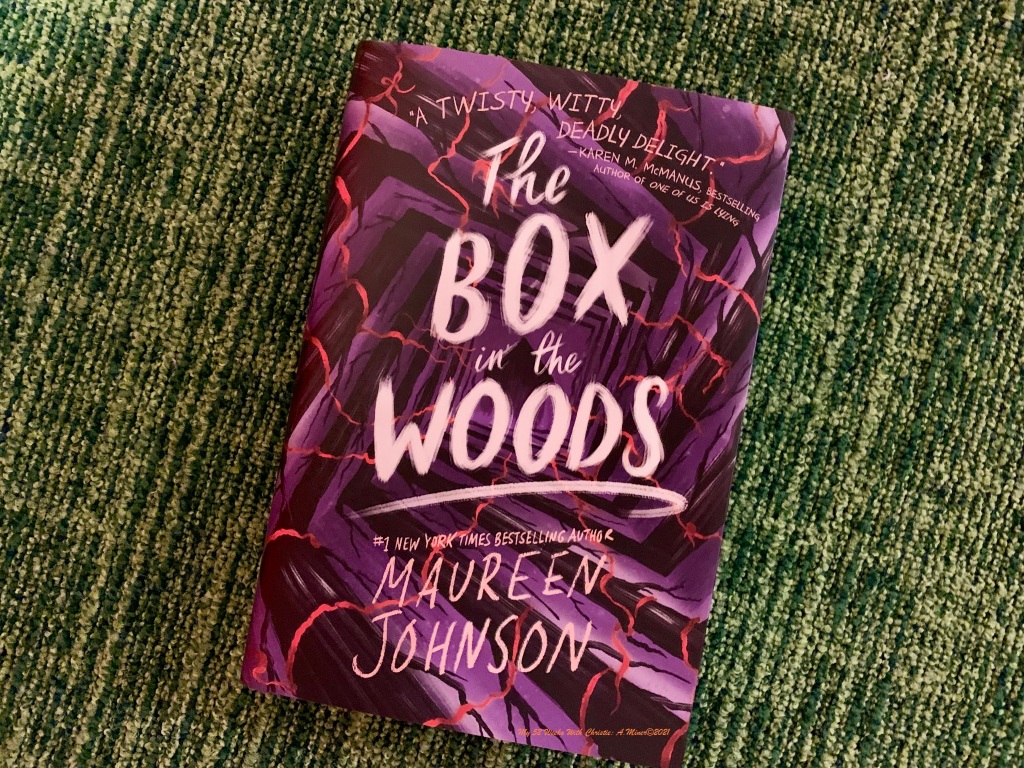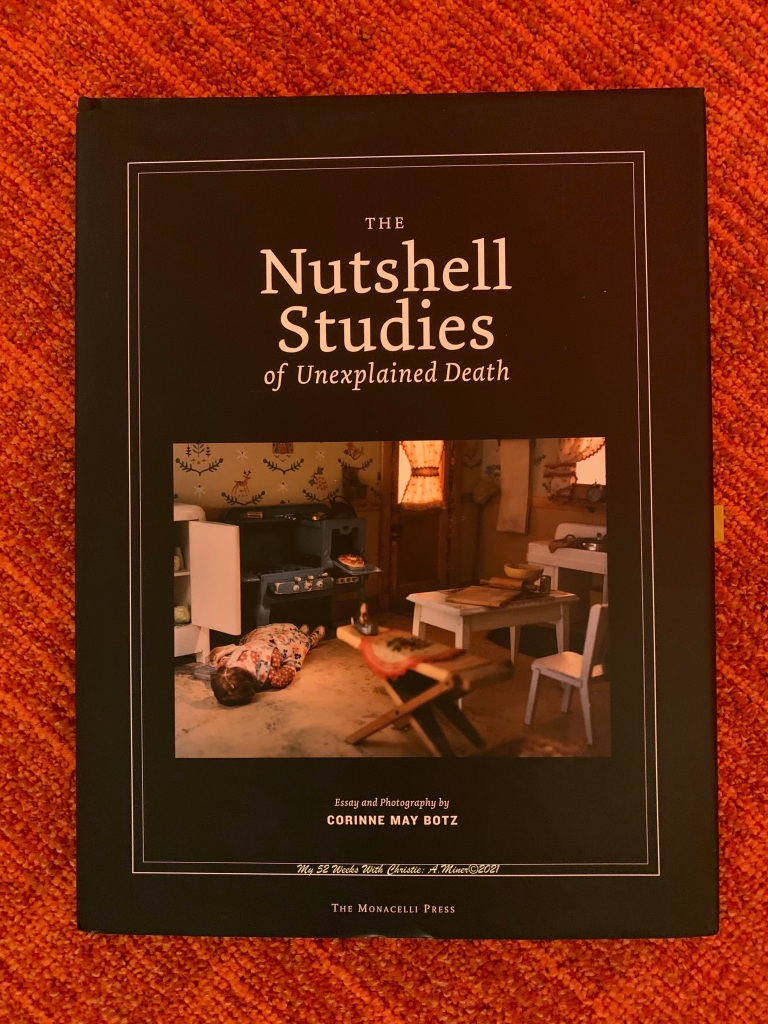
The Box In The Woods – Maureen Johnson
The Box In The Woods is probably one of the finest transitional books I’ve read – period.
A bold statement, to be sure, but I think an accurate one nonetheless.
The Box in the Woods is a continuation of Johnson’s Truly Devious series.
In that, a brand new cold case reunites Stevie and company during their summer vacation. Even better, if you’ve skipped reading the Truly Devious series and aren’t sure you want to sink in the extra time reading the trilogy (though you really should, they’re great), you don’t need to. Johnson brilliantly catches you up – without ruining the first three books!
Seriously, you don’t know how rare this is.
For some insane reason, mystery writers (or I suspect their editors as the more likely culprit) love revealing the ending of a previous mystery in newer installments! A feature that is fantastically frustrating if you accidentally start in the middle of the series. Thankfully, Johnson neatly sidesteps this common transgression.
But I digress.
Another reason why I enjoyed reading this book is Johnson makes use of two very well-known tropes and cunningly freshens them up.
Trope One: The horrors of summer camp as popularized by the Friday the 13th franchise.
Set a month or two after Stevie solved the Truly Devious case, Stevie’s hired to investigate the notorious Camp Wonder Falls murders, a cold case from 1978 where four camp counselors sneak out to hang out one summer night and are found murdered the following morning. Amplifying the horror of the crime is the fact neither the Sherriff nor State Police solved the crime. Leaving Barlow Corners, where Camp Wonder Falls and all four victims called home, in a state of animated suspension.
Amplifying this trope: Stevie and friends are hired as counselors to the newly revitalized (and renamed) summer camp as cover for said detecting.
While writing this review, I began to wonder: Does this trope have any real-world roots, or is it a purely fictional construct?
The answer sent me down an hours-long rabbit hole.
More specifically, I discovered an unsettling case dubbed the Oklahoma Girl Scout Murders. In 1977, Michele Heather Guse (9), Lori Lee Farmer (8), and Doris Denise Milner (10) were raped and murdered during a thunderstorm while attending Camp Scott (which was later shut down).
The Sherriff honed in on an escaped felon and convicted rapist who grew up in the area as his prime suspect. Gene Leroy Hart, said offender, was found not guilty of the girl’s murder in 1979. Other suspects have surfaced over the years, but no convictions have come about. Nor has DNA testing helped, as the biological material has deteriorated enough over the years that finding usable samples has become increasingly difficult.
Hauntingly, two months prior to the three little girl’s murder, a room was ransacked during a counselor’s training session. The perpetrator left a note stating, “We are on a mission to kill three little girls in Tent One.”.
The note, deemed a prank, was unfortunately tossed out.
(Click here if you’re interested in reading Tulsa World’s coverage of the tragedy. Or here for an alternate suspect theory.)
But back to The Box In The Woods.
The second trope Johnson used is one I’ve read at least a dozen times before – yet Johnson disguised it so cleverly I didn’t see it coming. Which I think is the mark of a great author and an excellent book.
Unfortunately, I can’t explain the trope any further. Otherwise, I will ruin the book for you. This is one where you need to trust me – the trope’s there, and it’s well-executed.
Overall, I would recommend this book to anyone who enjoys YA detectives (though it is only YA due to the ages of the sleuths and a few hormones) and/or those who enjoy Agatha Christie-esque mysteries.
Honestly, I can’t say enough good things about The Box In The Woods!

The Nutshell Studies of Unexplained Death – Essay & Photography by Corinne May Botz
Interestingly, the review of the Nutshell Studies is directly linked to The Box In The Woods. When Stevie is first approached about investigating the cold case at Wonder Falls, she knows her folks won’t be keen on the idea, as they don’t understand or entirely approve of her fascination with true crime. So Stevie devises a strategy – which involves using a book filled with photos of the Nutshell Studies – to secure her parent’s permission to become a counselor at the notorious camp.
Intrigued by Johnson’s description, I found the book Stevie was reading.
Whereupon I discovered I’d seen homages to these scaled works in Elementry, CSI: Las Vegas, and Father Brown.
Created by Frances Glessner Lee, the mother of forensic science in the United States, these dioramas are intended to help train investigators on how to approach and analyze crime scenes.
Each scene is a 1-foot to 1-inch scale replica of crime scenes Lee either read about or visited. And much like Dragnet, Lee altered the specifics of each case she used, lest the detectives already know the solution. Though small, these gruesome dollhouses are fully immersive crime scenes where only one of three outcomes were acceptable – accident, suicide, or murder.
Brining us to Botz’s book.
Botz’s photography of these tiny worlds is both haunting, eerily lovely and acquaints her readers with the specter at the feast. All the while keeping true to Lee’s goal for the Nutshell Studies.
And this is where my criticism of this book lies.
Authors and Readers don’t always have the same agenda when beginning a book. And that’s okay. However, it is the duty of the author to set a clear message for their audience – particularly when dealing with such a tantalizing and fascinating subject like the Nutshell Studies.
Because, much like Stevie in The Box In The Woods, I wanted to hone my own critical thinking skills and eye on dioramas meant to do just that.
And this is where the rub of the book lies.
Botz waited until page 220 of 223 in a footnote, no less, to inform her readers she only included the solution to five out of twenty Nutshell Studies. (And one other tiny pet peeve the few provided solutions aren’t listed in the order the cases were presented in the previous chapter.) In any case, the reason for this purposeful omission is due to the fact law enforcement still use the Nutshell Studies as training tools. So they asked Botz not to reveal three-quarters of the solutions.
Which is entirely understandable and isn’t the basis of my quibble.
My objection lies in waiting until the last four pages to finally elucidate this crucial detail – Botz could’ve just as easily placed the footnote in her prologue (which would’ve avoided a great deal of frustration and annoyance).
Admittedly, in Botz’s preface, she does allude to this contentious detail. Stating she set out to photograph the Nutshell Studies, “With the resolve of an investigator at the scene of a crime (yet with no interest in solving it)…” (pg. 12). Additionally, Botz felt a kinship with Lee – which meant Botz kept true to Lee’s intent for the Nutshells, “…they were not supposed to treat the Nutshells as ‘whodunnits’…they are, rather, designed as exercises in observing and evaluating indirect evidence…” (pg. 29).
This obfuscation of information continues with the photographs, as Botz only gives the audience small slices of these miniatures to study. Now, these slices are spectacular in their incredible detail, meticulous craftsmanship, and atmospheric perspective – but they do not afford the same opportunity for the reader as they do investigators.
Happily, Botz does include the background info written by Lee for each diorama. Then provides a crime scene diagram of each overall scene where Botz highlights investigative features, the personal quirks Lee buried within the rooms or just general fun facts. They draw the reader’s eye hither, thither, and yon much like a red herring in a mystery novel.
Now, with all this being said – and I know my criticism is rather long – I would still highly recommend reading this book. Although, with the caveat, the cases may leave you a bit frustrated with not knowing the answers…In any case, the sheer precision and accuracy of Lee’s dioramas is astonishing, and Botz’s photography elevates the Nutshell Studies to a whole new level. Making Botz’s book The Nutshell Studies of Unexplained Death deserving of your time and energy. Because I bought this book several months back, and I still find something new each and every time I reread it.
You must be logged in to post a comment.